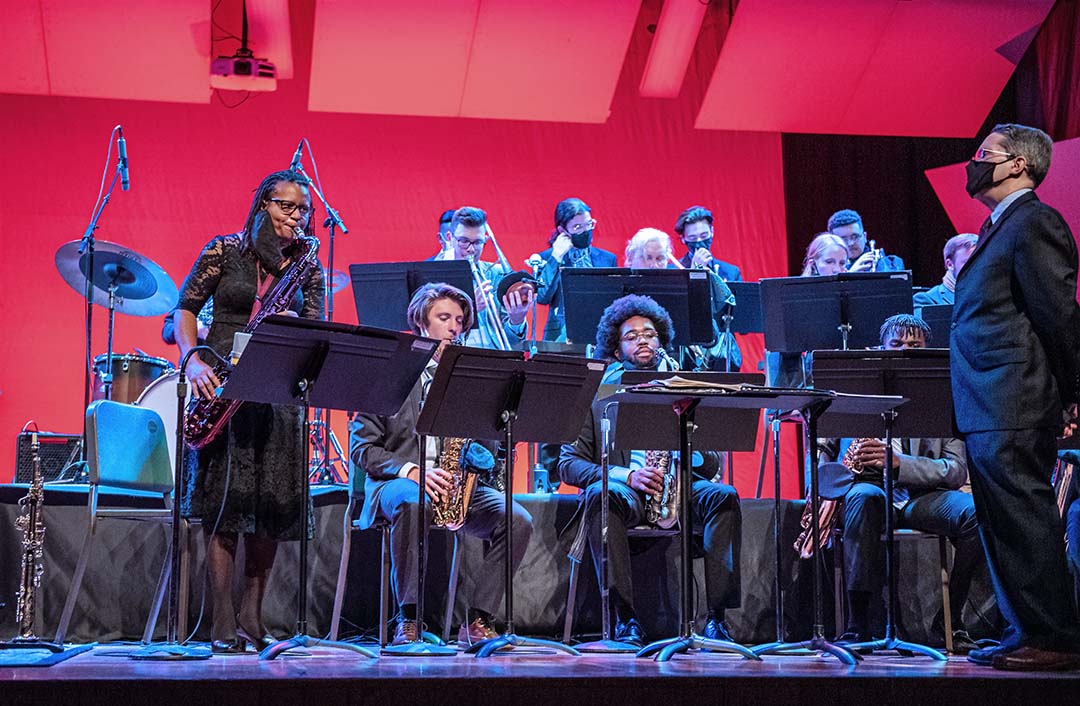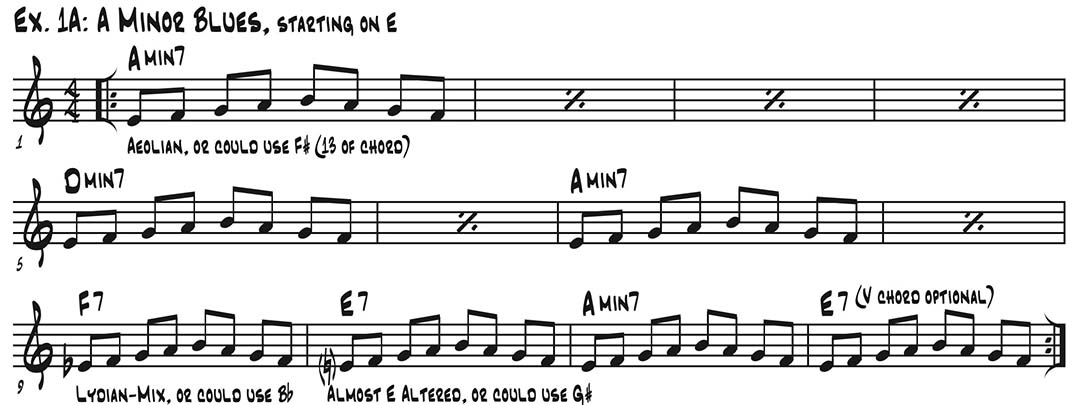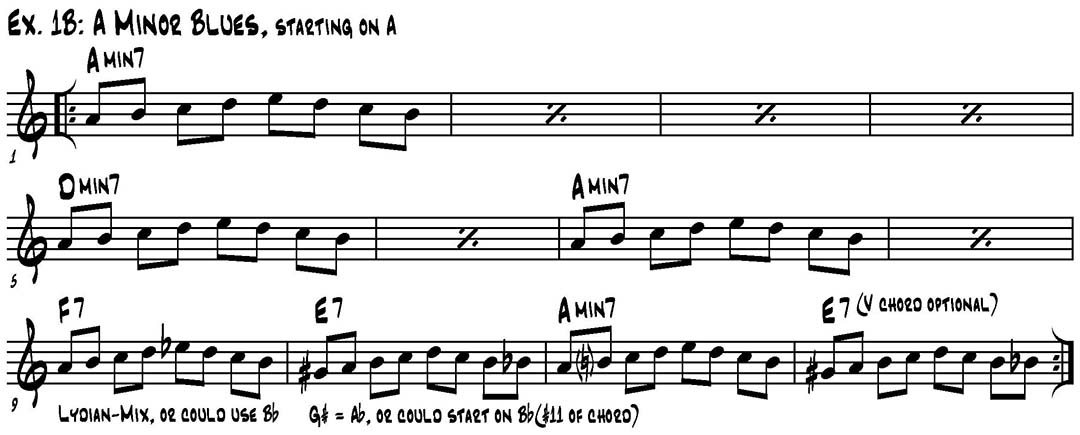 |
Student Tará Davis solos with the Virginia Commonwealth University Jazz Orchestra I, |
|
This article is copyright 2019 by Antonio J. García and originally was published in Down Beat, Vol. 89, No. 4, April 2022. It is used by permission of the author and, as needed, the publication. Some text variations may occur between the print version and that below. All international rights remain reserved; it is not for further reproduction without written consent. |
Five-Note Morphing: a Path to Improv Success
Masterclass
by Antonio J. García
 |
Student Tará Davis solos with the Virginia Commonwealth University Jazz Orchestra I, |
Improvisation by key centers, by blues scale, or via the ability to play any note convincingly over any chord are always options. Here I explore a fourth avenue: being literal with each chord change, responding with chromatic decisions that conform to the symbol of the moment.
If you’re a more experienced improvisor, questions may arise in your head: “Can I really play on the chord changes? Or do my lines stop every time I play a color-tone?” If you’re less-experienced: “Am I ready to go beyond scale-steps 1, 3, 5, and 7 and hear 9, 11, and 13? Or do I run from them?”
Jazz education for less-experienced improvisation-levels tends to focus on requiring mastery of full scales. Yet:
So if great, lyrical lines can be constructed from just a few notes, why not focus for a while on mastering half-scales that originate from a single pitch-name throughout the piece, adjusting chromatically as needed to address the shifting harmonies? I call this “Five-Note Morphing” and have found it to be the single best indicator as to whether a student—or I—can successfully “make the changes” while improvising over a given tune.
This approach is as effective or more so for vocal improvisers and for developed classical musicians, yet it is very different from learning scales from each chord-root. And it’s just as relevant for advanced improvisors on very challenging chord changes: you’ll be forced to address the chords and related scale-steps in ways you might otherwise avoid. I call it “the great lie-detector” because if you’ve been faking your way through the chord changes, you’ll hit a full-stop quickly in this exercise.
Variables
Recognition of a given chord’s third and seventh is critical. But decisions as to whether to proceed through a natural ninth or a flatted one, or a natural fifth or a raised one, are up to you. What does the flavor of the melody of the tune at that point suggest? Do you wish to reinforce or defy that? An initial approach can often be to shift as little as possible from the preceding or following chord’s key-center, as that will minimize mental interruption to the improvisor and thus potentially maximize your lyricism as the chords move by (as in my book Cutting the Changes: Jazz Improvisation via Key Centers).
Where you start your five-note pattern is also up to you. Regardless, you’ll end up covering all the letter-names of the scale, as part one of the exercise is to perform a five-note scale up and down; part two is to start on the fifth note of that exercise and begin a new five-note pattern from there, thus covering a total of a ninth.
You can then explore starting the exercise from any scale-step of your choice; and you’ll never lose one of the most important elements of the drill: whereas in improv-practice it’s easy to avoid certain tones, in Five-Note Morphing you have to address every letter-name. By doing so, you’ll get your ear attuned to 11ths, 13ths, and altered 5ths and 9ths that you likely would otherwise have avoided for as long as possible—and which would have caused you to doubt your solo-line even when hitting a very “tasty,” correct note!
If you’re new to swing, first perform these in even-eighth bossa nova style. But eventually you have to perform them in swing; do so at as slow a tempo as you need to be accurate. You’ll find repeats here to “vamp” the drill, plus the occasional passing-tone to facilitate a repeat. If you’re an instrumentalist, singing these exercises will benefit you greatly, placing the sounds in your mind’s ear before you reach them on your instrument.
My final advice: though I am providing you written examples for pedagogical purposes, I strongly encourage you to teach this approach strictly by ear, at least for blues and simpler chord progressions. You and your students will then develop aural recognition of the darker and lighter tonal colors associated with shifting chords—invaluable!
(For your own ease of study off-line,
click here to download a printable PDF collection of all of the following musical examples in C Treble, C Bass, Bb, Eb,
and F;
and click here to download an mp3 file of the audio for the examples. You can, however, see and hear all the examples below on this web page.)
A Minor Blues
I have great results starting with A minor blues: see why in Ex. 1A! (Click on any musical example to hear the related audio.)
 |
Comping aside, this path of Ex. 1A is so easy for middle-school soloists that often I’ll teach measures 1 and 9, then simply tell them to watch for my “thumbs-down” signal in bar 9 and “thumbs-up” in bar 10 as they either play the exercise or solo within the five notes.
Ex. 1B is a bit more challenging in mm. 10 and 12—but doable with just a bit of practice!
 |
You can still teach it by ear, then remind students in real-time by calling out or using flash cards. Remember: the final V-chord is optional!
F Basic Blues
Comping aside, for a basic F blues the first 8 bars of Ex. 2A are identical; so I can even use a “thumbs-up” in mm. 9 and 12, plus a “thumbs-down” in mm. 11 and 1, to cue the E natural or Eb.
 |
I can point out later our use of C minor and major scales. And now we have Lydian-Mixolydian in a different measure!
Ex. 2B is of similar difficulty. And I can point out later our use of F major and F minor scales—perhaps even E half-diminished (still F major), if that won’t confuse the participant(s).
 |
Bb Rhythm Changes
Comping aside, you can solo over the A sections of “rhythm changes” (based on the chords to Gershwin’s “I Got Rhythm”) entirely with the Bb major (Ionian) or Bb dominant (Mixolydian) scale, as well as the blues scale. So let’s focus on the bridge, which changes to three other keys before returning in its last two bars to the home key of Bb. Ex. 3A shows minimal pitch-shifts are needed.
 |
Again, you can hold two, one, or no fingers up to signal the number of accidentals needed at a given point. Sometimes I use flash-cards that simultaneously show the number of accidentals needed in the keys of most band instrumentation: C, Bb, Eb, and F concert!
Ex. 3B requires a shift every two bars, from G, C, F, to Bb, also possible with flash-cards.
 |
Standard Tune: “Satin Doll”
Let’s look at a “standard tune,” which can be more complex. Ex. 4A addresses the four key centers that appear in the initial A section of “Satin Doll”: C, D, G, and Gb (or in part, Db).
 |
This illustrates how important it is across the two iterations of the exercise to negotiate each pitch (that you might otherwise easily avoid if only improvising during practice)
Both Ex. 4A and Ex. 4B require a small leap from the end of m. 6 to the beginning of m. 7—but to either the fifth or first scale-degree of the key; so they’re quite doable with a little practice.
 |
After the drills, invite the students to solo using just half-scales with the same letter names.
Variations on Morphing
The preceding examples carry the same five notes throughout a measure. But you can adapt Five-Note Morphing to a harmonic rhythm of half-notes (shifting to the new scale in the second half of the bar) or of quarter notes (changing the scale every beat). It’s as relevant for practicing a John Coltrane or Wayne Shorter tune as it is for blues and standards: as long as you proceed up five notes and down five notes (if in 4/4), you’ll be forced to address the chords and related scales in ways you might otherwise avoid. Once achieved, you’ll be confident that you can play any pitch-name over any chord.
Again, for offline practice you can download C Treble, C Bass, Bb, Eb, and F versions of these musical examples here, plus mp3 rhythm-section play-along accompaniment here.
_ _ _ _ _ _ _ _ _ _ _ _ _ _ _
Antonio J. García is a Professor Emeritus and former Director of Jazz Studies at Virginia Commonwealth University, where he directed the Jazz Orchestra I; instructed Applied Jazz Trombone, Small Jazz Ensemble, Jazz Pedagogy, Music Industry, and various jazz courses; founded a B.A. Music Business Emphasis (for which he initially served as Coordinator); and directed the Greater Richmond High School Jazz Band. An alumnus of the Eastman School of Music and of Loyola University of the South, he has received commissions for jazz, symphonic, chamber, film, and solo works—instrumental and vocal—including grants from Meet The Composer, The Commission Project, The Thelonious Monk Institute, and regional arts councils. His music has aired internationally and has been performed by such artists as Sheila Jordan, Arturo Sandoval, Jim Pugh, Denis DiBlasio, James Moody, and Nick Brignola. Composition/arrangement honors include IAJE (jazz band), ASCAP (orchestral), and Billboard Magazine (pop songwriting). His works have been published by Kjos Music, Hal Leonard, Kendor Music, Doug Beach Music, ejazzlines, Walrus, UNC Jazz Press, Three-Two Music Publications, Potenza Music, and his own garciamusic.com, with five recorded on CDs by Rob Parton’s JazzTech Big Band (Sea Breeze and ROPA JAZZ). His scores for independent films have screened across the U.S. and in Italy, Macedonia, Uganda, Australia, Colombia, India, Germany, Brazil, Hong Kong, Mexico, Israel, Taiwan, and the United Kingdom. He has fundraised $5.5 million in external gift pledges for the VCU Jazz Program, with hundreds of thousands of dollars already in hand.
A Bach/Selmer trombone clinician, Mr. García serves as the jazz clinician for The Conn-Selmer Institute. He has freelanced as trombonist, bass trombonist, or pianist with over 70 nationally renowned artists, including Ella Fitzgerald, George Shearing, Mel Tormé, Doc Severinsen, Louie Bellson, Dave Brubeck, and Phil Collins—and has performed at the Montreux, Nice, North Sea, Pori (Finland), New Orleans, and Chicago Jazz Festivals. He has produced recordings or broadcasts of such artists as Wynton Marsalis, Jim Pugh, Dave Taylor, Susannah McCorkle, Sir Roland Hanna, and the JazzTech Big Band and is the bass trombonist on Phil Collins’ CD “A Hot Night in Paris” (Atlantic) and DVD “Phil Collins: Finally...The First Farewell Tour” (Warner Music). An avid scat-singer, he has performed vocally with jazz bands, jazz choirs, and computer-generated sounds. He is also a member of the National Academy of Recording Arts & Sciences (NARAS). A New Orleans native, he also performed there with such local artists as Pete Fountain, Ronnie Kole, Irma Thomas, and Al Hirt.
Mr. García is a Research Faculty member at The University of KwaZulu-Natal (Durban, South Africa) and the Associate Jazz Editor of the International Trombone Association Journal. He has served as a Network Expert (for Improvisation Materials), President’s Advisory Council member, and Editorial Advisory Board member for the Jazz Education Network . His newest book, Jazz Improvisation: Practical Approaches to Grading (Meredith Music), explores avenues for creating structures that correspond to course objectives. His book Cutting the Changes: Jazz Improvisation via Key Centers (Kjos Music) offers musicians of all ages the opportunity to improvise over standard tunes using just their major scales. He is Co-Editor and Contributing Author of Teaching Jazz: A Course of Study (published by NAfME), authored a chapter within Rehearsing The Jazz Band and The Jazzer’s Cookbook (published by Meredith Music), and contributed to Peter Erskine and Dave Black’s The Musician's Lifeline (Alfred). Within the International Association for Jazz Education he served as Editor of the Jazz Education Journal, President of IAJE-IL, International Co-Chair for Curriculum and for Vocal/Instrumental Integration, and Chicago Host Coordinator for the 1997 Conference. He served on the Illinois Coalition for Music Education coordinating committee, worked with the Illinois and Chicago Public Schools to develop standards for multi-cultural music education, and received a curricular grant from the Council for Basic Education. He has also served as Director of IMEA’s All-State Jazz Choir and Combo and of similar ensembles outside of Illinois. He is the only individual to have directed all three genres of Illinois All-State jazz ensembles—combo, vocal jazz choir, and big band—and is the recipient of the Illinois Music Educators Association’s 2001 Distinguished Service Award.
Regarding Jazz Improvisation: Practical Approaches to Grading, Darius Brubeck says, "How one grades turns out to be a contentious philosophical problem with a surprisingly wide spectrum of responses. García has produced a lucidly written, probing, analytical, and ultimately practical resource for professional jazz educators, replete with valuable ideas, advice, and copious references." Jamey Aebersold offers, "This book should be mandatory reading for all graduating music ed students." Janis Stockhouse states, "Groundbreaking. The comprehensive amount of material García has gathered from leaders in jazz education is impressive in itself. Plus, the veteran educator then presents his own synthesis of the material into a method of teaching and evaluating jazz improvisation that is fresh, practical, and inspiring!" And Dr. Ron McCurdy suggests, "This method will aid in the quality of teaching and learning of jazz improvisation worldwide."
About Cutting the Changes, saxophonist David Liebman states, “This book is perfect for the beginning to intermediate improviser who may be daunted by the multitude of chord changes found in most standard material. Here is a path through the technical chord-change jungle.” Says vocalist Sunny Wilkinson, “The concept is simple, the explanation detailed, the rewards immediate. It’s very singer-friendly.” Adds jazz-education legend Jamey Aebersold, “Tony’s wealth of jazz knowledge allows you to understand and apply his concepts without having to know a lot of theory and harmony. Cutting the Changes allows music educators to present jazz improvisation to many students who would normally be scared of trying.”
Of his jazz curricular work, Standard of Excellence states: “Antonio García has developed a series of Scope and Sequence of Instruction charts to provide a structure that will ensure academic integrity in jazz education.” Wynton Marsalis emphasizes: “Eight key categories meet the challenge of teaching what is historically an oral and aural tradition. All are important ingredients in the recipe.” The Chicago Tribune has highlighted García’s “splendid solos...virtuosity and musicianship...ingenious scoring...shrewd arrangements...exotic orchestral colors, witty riffs, and gloriously uninhibited splashes of dissonance...translucent textures and elegant voicing” and cited him as “a nationally noted jazz artist/educator...one of the most prominent young music educators in the country.” Down Beat has recognized his “knowing solo work on trombone” and “first-class writing of special interest.” The Jazz Report has written about the “talented trombonist,” and Cadence noted his “hauntingly lovely” composing as well as CD production “recommended without any qualifications whatsoever.” Phil Collins has said simply, “He can be in my band whenever he wants.” García is also the subject of an extensive interview within Bonanza: Insights and Wisdom from Professional Jazz Trombonists (Advance Music), profiled along with such artists as Bill Watrous, Mike Davis, Bill Reichenbach, Wayne Andre, John Fedchock, Conrad Herwig, Steve Turre, Jim Pugh, and Ed Neumeister.
The Secretary of the Board of The Midwest Clinic and a past Advisory Board member of the Brubeck Institute, Mr. García has adjudicated festivals and presented clinics in Canada, Europe, Australia, The Middle East, and South Africa, including creativity workshops for Motorola, Inc.’s international management executives. The partnership he created between VCU Jazz and the Centre for Jazz and Popular Music at the University of KwaZulu-Natal merited the 2013 VCU Community Engagement Award for Research. He has served as adjudicator for the International Trombone Association’s Frank Rosolino, Carl Fontana, and Rath Jazz Trombone Scholarship competitions and the Kai Winding Jazz Trombone Ensemble competition and has been asked to serve on Arts Midwest’s “Midwest Jazz Masters” panel and the Virginia Commission for the Arts “Artist Fellowship in Music Composition” panel. He was published within the inaugural edition of Jazz Education in Research and Practice and has been repeatedly published in Down Beat; JAZZed; Jazz Improv; Music, Inc.; The International Musician; The Instrumentalist; and the journals of NAfME, IAJE, ITA, American Orff-Schulwerk Association, Percussive Arts Society, Arts Midwest, Illinois Music Educators Association, and Illinois Association of School Boards. Previous to VCU, he served as Associate Professor and Coordinator of Combos at Northwestern University, where he taught jazz and integrated arts, was Jazz Coordinator for the National High School Music Institute, and for four years directed the Vocal Jazz Ensemble. Formerly the Coordinator of Jazz Studies at Northern Illinois University, he was selected by students and faculty there as the recipient of a 1992 “Excellence in Undergraduate Teaching” award and nominated as its candidate for 1992 CASE “U.S. Professor of the Year” (one of 434 nationwide). He is recipient of the VCU School of the Artsí 2015 Faculty Award of Excellence for his teaching, research, and service and in 2021 was inducted into the Conn-Selmer Institute Hall of Fame. Visit his web site at <www.garciamusic.com>.
If you entered this page via a
search engine and would like to visit more of this site,